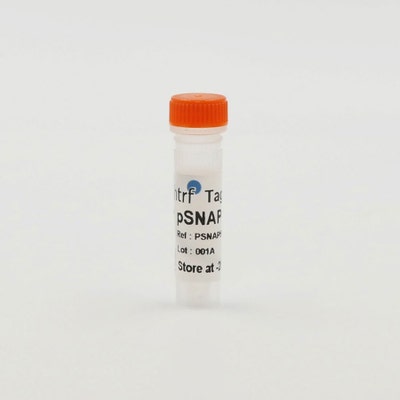

Tag-lite pSNAP-5HT1A Plasmid, 10 µg


Tag-lite pSNAP-5HT1A Plasmid, 10 µg






The Tag-lite 5HT1A 5-Hydroxytryptamine 1A plasmid is used to transiently or stably transfect cells for the purpose of developing a 5HT1A 5-Hydroxytryptamine 1Areceptor binding assay.
For research use only. Not for use in diagnostic procedures.
| Feature | Specification |
|---|---|
| Application | Receptor-Ligand Binding |
The Tag-lite 5HT1A 5-Hydroxytryptamine 1A plasmid is used to transiently or stably transfect cells for the purpose of developing a 5HT1A 5-Hydroxytryptamine 1Areceptor binding assay.
For research use only. Not for use in diagnostic procedures.



Tag-lite pSNAP-5HT1A Plasmid, 10 µg



Tag-lite pSNAP-5HT1A Plasmid, 10 µg



Product information
Overview
Over past few years, SNAP-Tag technology combined with TR-FRET has paved way development of many non-radioactive, no-wash, binding assays. method is based on transfecting cells using plasmids encoding a SNAP-Tag and subsequently labeling m with Terbium. Revvity offers a large collection of such plasmids. All GPCR genes are cloned in an expression vector directly downstream from a CMV promoter, and are provided ready protein expression and labeling.
All information on this page pertains to Tag-lite plasmid cloned with 5HT1A 5-Hydroxytryptamine 1A receptor.
Specifications
| Application |
Receptor-Ligand Binding
|
|---|---|
| Brand |
Tag-lite
|
| Detection Modality |
HTRF
|
| Product Group |
Plasmids
|
| Shipping Conditions |
Shipped in Dry Ice
|
| Target Class |
GPCR
|
| Technology |
TR-FRET
|
| Therapeutic Area |
Cardiovascular
Infectious Diseases
Metabolism/Diabetes
NASH/Fibrosis
Neuroscience
Oncology & Inflammation
Rare Diseases
|
| Unit Size |
1 Item
|
Video gallery

Tag-lite pSNAP-5HT1A Plasmid, 10 µg

Tag-lite pSNAP-5HT1A Plasmid, 10 µg

How it works
Step 1 - Plasmid transfection
Use standard transfection techniques (refer to transient transfection protocol) to transiently express the SNAP-GPCR of interest in your cell line.
Step 2 - Receptor labeling
SNAP-tag®, is a small fusion tag that covalently interacts with specific substrates. SNAP-tag allows specific and covalent labeling of any protein of interest (refer to labeling procedure). Cells are provided unlabeled and need to be labeled with Lumi4-Terbium prior to running a binding assay. Labeling reagents are available from the Revvity catalog in 4 different sizes.

Step 3 - Understand the assay principle
Running a receptor binding assay using Tag-lite is as easy as it can get. Simply dispense 10 µL of labeled cells into each well, followed by 5 µL of labeled ligand and 5 µL of the compound you wish to test. Like all HTRF assays, Tag-lite assays do not require any washing steps. A diagram of the procedure to be followed is given on the right.

Step 4- Saturation binding (KD)
A saturation binding assay measures total and non-specific binding for increasing concentrations of ligand under equilibrium conditions. To perform the assay, the fluorescent ligand is titrated into a solution containing a fixed amount of labeled cells and then incubated to equilibrium. The HTRF ratio obtained from this titration is the total binding.


Step 5 - Competitive binding (KI)
A competitive binding assay is performed to measure the dissociation constant, Ki. To perform the assay, the compound is titrated into a solution containing a fixed concentration of fluorescent ligand and a fixed amount of cells.


Resources
Are you looking for resources, click on the resource type to explore further.
G-protein coupled receptors (GPCRs) are crucial transmembrane proteins involved in cellular signal transduction.
This technical...


How can we help you?
We are here to answer your questions.






























